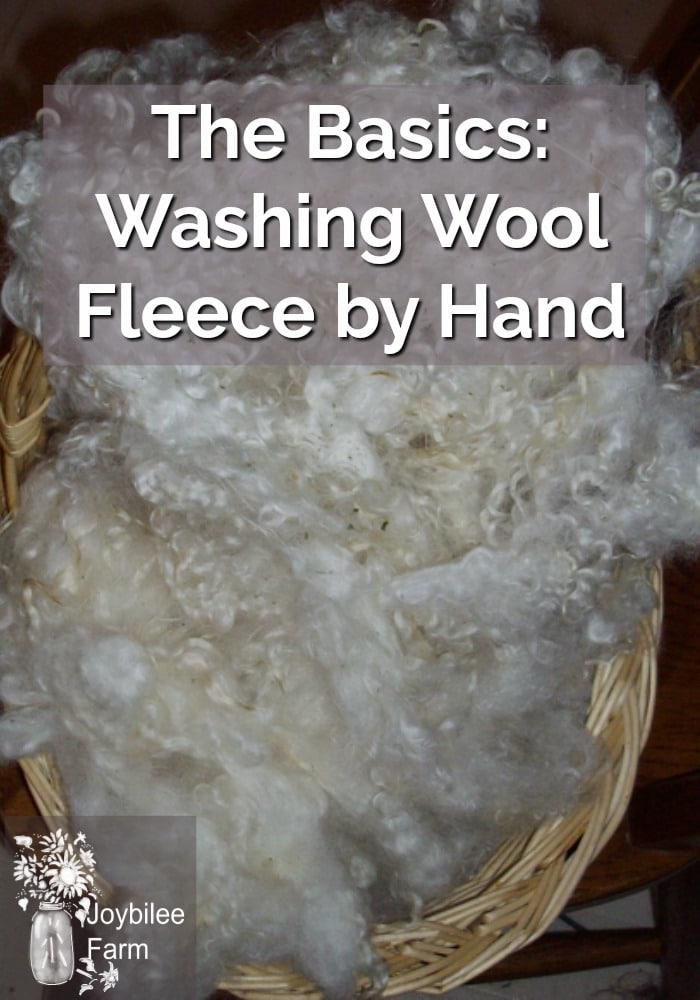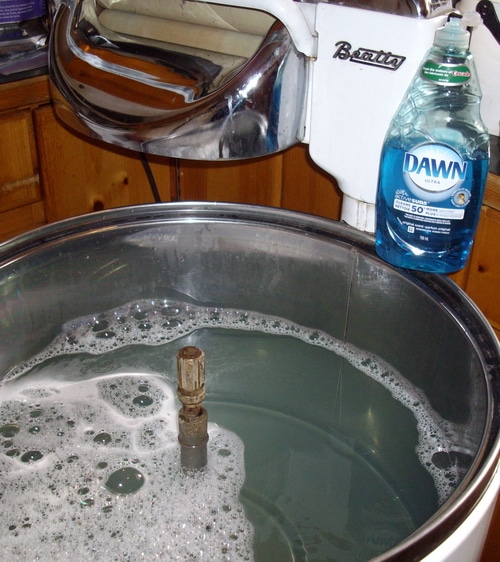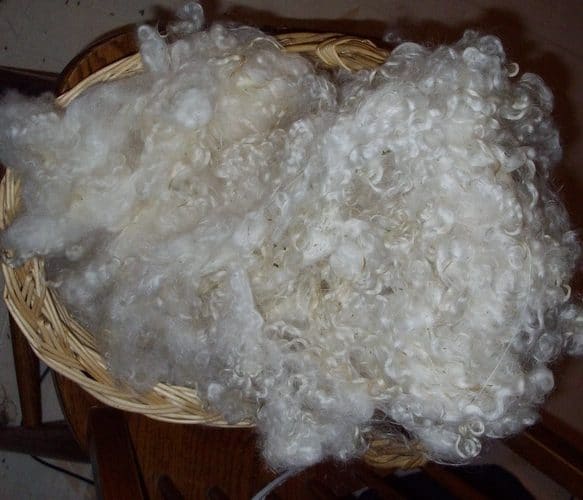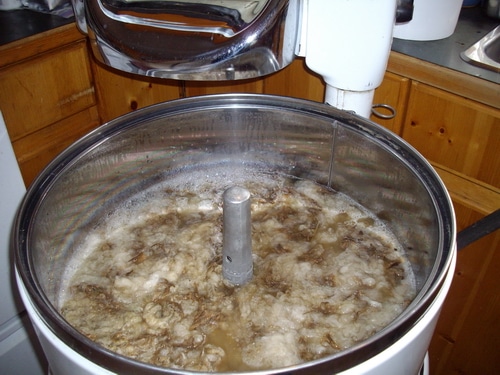How to Wash Wool Fleece by Hand
Tutorial to teach you the best way for washing wool fleece by hand for spinning, felting, or knitting.

Washing wool fleece is the first step to getting it ready for carding. Once the fleece is carded it’s ready to use for felting or spinning it into yarn. Washing the fleece is the foundational step to a successful project. Get this step right and all the next steps will go smoothly and you will get the product at the other end that you desire. Scrimp at this stage and you’ll be struggling with every step hereafter.
Wool fleece is greasy and full of sheep sweat and dirt. You need to remove this sweat, dirt, and lanolin (a combination of grease and wax) from the wool to make it easier to work with. You also want to do it without destroying your hands or harming the fleece. It’s not a difficult job if you follow some basic principles. But overlook the basic principles for cleaning fleece and you will have a mess.
Before you card your wool: Basic principles of washing wool fleece by hand
- Wool has a proclivity to felt when wet. So wool fleece needs to be handled gently when it is damp or wet.
- Use Original Dawn as the sudsing medium
- Keep the water hot
- Don’t change the temperature of the water suddenly
- Don’t agitate wet wool
- Keep the washing water on the acidic side of 7.
- Use a large capacity basin that you can cover to keep the heat in.
- Wash twice, Rinse as many times as necessary to get the water clear
Now, let’s look at these principles more closely and I’ll explain the reason behind each principle. Once you understand the reason behind each basic principle I’ll show you how I apply this to my own wool washing.
Wool’s Proclivity to Felt
While not all wool will felt, most lustre wools and many of the fine wools will felt easy. This is an important value for the felt maker. You can test the fleece you are going to wash for its proclivity to felt by grabbing a few locks, wetting your hands and adding soap and rolling the fleece into a ball. If it refuses to felt, no matter how much you abuse it in this manner, your fleece should be used in an application where felting isn’t necessary. It will also be easier to wash. Most wool fleeces will felt.
Felt makers use these qualities to their advantage by shocking the wool with drastic changes in temperature, and by agitating and manipulating the wool. So to avoid felting when washing wool you will need to avoid temperature shocking or rough handling of the wool, while the fleece is wet.
Use Dawn

Use Dawn dishwashing detergent to degrease and clean the fleece. I don’t normally give you specific product recommendations for your homestead but I make an exception when it comes to washing fleece. Dawn is the very best degreaser available for household use. Dawn is the very best option for water with a high mineral content — ie. hard water. If you have soft water you have a few more options open to you. Orvus paste is also used for fleece washing but it is only effective with soft water. Ditto for homemade soap. Most liquid detergents, while doing a fair job at cleaning dishes in hard water, don’t have the degreaser that Dawn has. I’ve been disappointed by other brands of dishwashing detergents when I’ve used them instead of Dawn for fleece washing.
Dawn Non-Ultra Original Scent Dishwashing Liquid 56 Fl Oz (Pack of 8)
Dawn is used for cleaning up birds during oil spills. It’s that effective as a degreaser. I buy bottles of Dawn and reserve specifically for fleece washing, even when I use other options for washing dishes. Dawn is a chemical and will denature the protein in your hands (it’s used to break the cell walls in DNA experiments, too). Always wear gloves when putting your hands in water that you’ve added Dawn to.
I use 1/2 cup of Dawn per washer load — so about 1 cup of Dawn per fleece, for the 2 washes that I do. A 700ml bottle of Dawn will last you for only 3 fleeces, at a cost of about $1.35 per fleece. Don’t try to save money by using less Dawn. I have hard water. If you have soft water and your fleeces aren’t very dirty, you may get by with half that. Judge your fleece for cleanliness after it is dry and has been in storage for at least 3 months. And then adjust your procedure according to your results with your water.
Use Hot water at each step
We set the thermostat on our hot water tank at 130F when washing wool. Lanolin melts at 120F but if the water temperature drops to 110F, lanolin will redeposit on your wool. So we start with 130F water and keep it at this temperature at each stage of the wool washing process — for 2 washes and for 2 or 3 rinses.
Don’t change the water temperature suddenly
When washing wool, you want to keep the temperature of the rinse water the same temperature as the water you just took the fleece out of. So while 130F is a good temperature to aim for, if you forget about the fleece for several hours, and the water cools down, you’ll want to put the next tub of water at the same temperature as the water you just took the fleece from. If you need to reheat it back to 130F because the lanolin has redeposited, simply increase the temperature slowly by adding hotter water, a little at a time until the desired temperature is reached.
If you are spinning your fleece out in your washing machine, make sure the cold water rinse is turned off. You don’t want to spray cold water on your hot fleece, while it is spinning out.
Never agitate wool when it is wet
If you are washing the fleece in a washing machine, don’t turn on the agitation. And when you want to spin it out or change from the wash water to the rinse water, lift the fleece out of the machine while doing so. This will keep your fleece from felting and prevent the dirt from redepositing on the wool.
Keep the pH of the wool on the acidic side of 7
Alkaline pH will harm the wool and make it coarse. If the pH is high enough, the wool fibres will dissolve completely. Wool is an acid fibre and is softest and has a kinder hand when the pH of the washing water remains at 7 (neutral pH) or below. A bit of vinegar or lemon juice added to the first rinse will keep the fleece soft and return it to its ideal pH, after washing with detergent.
Use a large capacity basin that you can cover for wool washing
While you can wash wool locks one handful at a time in the kitchen sink, when you are working through several fleeces each season, you’ll want to streamline the process. The ideal container for fleece washing is insulated to hold in the heat, can hold 5 to 8 lbs of fleece at one time without overcrowding, (5 to 8 lbs is the size of most skirted adult wool fleeces). Can be covered in order to hold in the heat and prevent the temperature from dropping.
I found that the best container for me is a wringer washing machine. Don’t use the pump, though, to drain out the water. To drain use gravity siphon action and drain into a bucket. The drain holes are large and wool can easily be sucked through and will damage the pump. By draining with the help of gravity, you don’t need power to the machine, and you save the pump for other times when you might need it for laundry.
You can remove the agitator to give you a larger capacity insulated tub. It has a lid to keep the heat from escaping. I add a thick bath towel to the lid when I am washing fleece outside. When I allow the machine to drain into a bucket so that I can use the dirty liquid in areas of the garden where we are not growing food. Rinse water can go into the vegetable garden, too.
Wash twice, Rinse as many times as necessary to get the water clear
Anything that isn’t rinsed out will be in the fleece when you pick it, card it, or felt it. Clean it really well, at this stage and the whole process will be more fun.
I like to wash it twice with detergent, and then rinse twice with clear water, and then do a final rinse with 1 cup of my special fleece rinse, to keep the fleece soft and repel moths while the wool is in storage.





You mention that the fleece should be stored for at least 3 months prior to washing. Why is that and how do you store your fleeces? Currently, I’m just learning how to wash and I am working with a fleece that was stored out in the snowy barnyard for about 8 months in a black garbage bag. 🙂 I’m expecting fresh fleeces in about June. But, I’d like to know when to wash them and how to store them properly. Thanks. 🙂